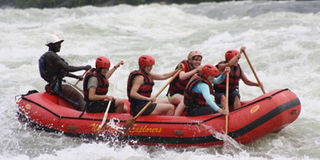Nile: a river of mysteries

Tourists raft on Bujagali Falls on River Nile. Courtesy Photo
What you need to know:
Mysterious. For some years now, various people have come up claiming to have found the “true” source of River Nile. But as many as the discoveries, so have the mysteries about the river increased.
They say all great mysteries begin at the end and end at the very beginning; River Nile is a perfect picture to accompany that phrase.
We all know where it ends, pouring northward through the sudans, where it meets its biggest tributary, the Blue Nile before heading to Egypt and finally into the Mediterranean Sea. But locating, let alone, agreeing on the origins of this magnificent river, has befuddled the world since time immemorial. The Bible and the Quran both hint on this mystery and both ancient and present day voyagers have waded in with their own suggestions.
John Hannington Speke has been principally credited as the man who discovered the source of the Nile which he pinned down at the Ripon Falls on Lake Victoria in Jinja centuries ago.
But almost every year, a new person claims to have found the “true” source of the world’s longest river and the debate goes on and on.
Last month, one of the world’s largest scientific and educational establishments; National Geographic, joined the fray as they premiered a television series titled Wild Nile on their NatGeo Wild platform (DStv Channel 182).
The series opens with an establishment shot of the sky-hugging Mountains of the Moon; then the camera rises from a tropical forest through alpine valleys to the glaciers that crown the various mountain ranges. Close-ups of the snow-capped peaks of Rwenzori is a sight to behold. The legendary three-horned chameleon and the shimmering Ruwenzori Turaco – both endemic to this region – make an early appearance on this naturally-embellished stage of geographic wonder. Rwenzori is dotted with many small rivers but it is River Mobuku – notoriously famous for flooding and swallowing human lives – that gets a good feature here.
Then the narrator elaborates that White Nile – which is the Nile’s headwaters – starts with the melting snow of Rwenzori and the rains of mountains of Rwanda and Burundi all which send their waters downwards into Lakes Edward and Albert before feeding Lake Victoria which eventually spouts the Nile out northwards.
Well, another rather other sources of the Nile. But the clearest of all things throughout this argument has always been that River Nile flows out of Lake Victoria at Jinja making it the only place where one can see something tangible to call a source. Jinja is the ‘official’ source of the Nile and it was recently declared one of the seven wonders of Africa by the Seven Wonders of Africa Project.
About The documentary
The three-part documentary series looks critically at the different possible sources of the Nile before taking viewers on a truly spectacular journey along the Nile, revealing the secret lives of its inhabitants.
The first part Wild Nile. Paradise Found explores the different sources of the Nile while the second part Wild Nile: Heart Of Darkness continues the story from when the river leaves Lake Victoria to progress peacefully through Murchison Falls National Park until the third part Wild Nile: River Of Kings is introduced as the river reaches Sudan. The last part looks at the Blue Nile tributary which originates from Ethiopia. In Wild Nile: Paradise Found, which premiered on September 9, National Geographic claims that the “Nile’s source can be pinned down to the area of the Rwenzori mountain ranges in Uganda.”
Rwenzori, a possible source

Hippos in River Nile Photo by Kasirye Faiswal
But some experts have argued that a source of a river has to be a melting glacier at a higher altitude and it cannot be a lake because something else has to feed the lake first hence Rwenzori Mountain and other water bodies around the great lakes region coming into the picture here.
Gladly, National Geographic doesn’t allow the bigger story of the significance of the Nile to the people and wildlife living on its banks it to get lost into the argument of the source.
The series confirms just how, for instance, in Uganda alone – the Nile has a herculean effect on the people and wildlife creating and supporting some of the country’s best tourism products.
Straight from the source at Jinja, the Nile turns Uganda into the best adventure destination in the region thanks to a range of activities, including the best white-water rafting in the world, bungee jumping, quad biking and camping.
Move to Murchison Falls and the Nile presents a spectacle of a waterfall squeezing through a 6-metre rocky gorge to fall 43 metres which is the hardest water drop in the whole world.
This is no ordinary river and this definitely is not an ordinary storyline of source to sea; Wild Nile series explores the countless waterways, islands and lakes that support the entire river system and looks at some of the river’s most fascinating inhabitants using state-of-the-art cameras to slow down and capture fast moving animals in all their glory.




